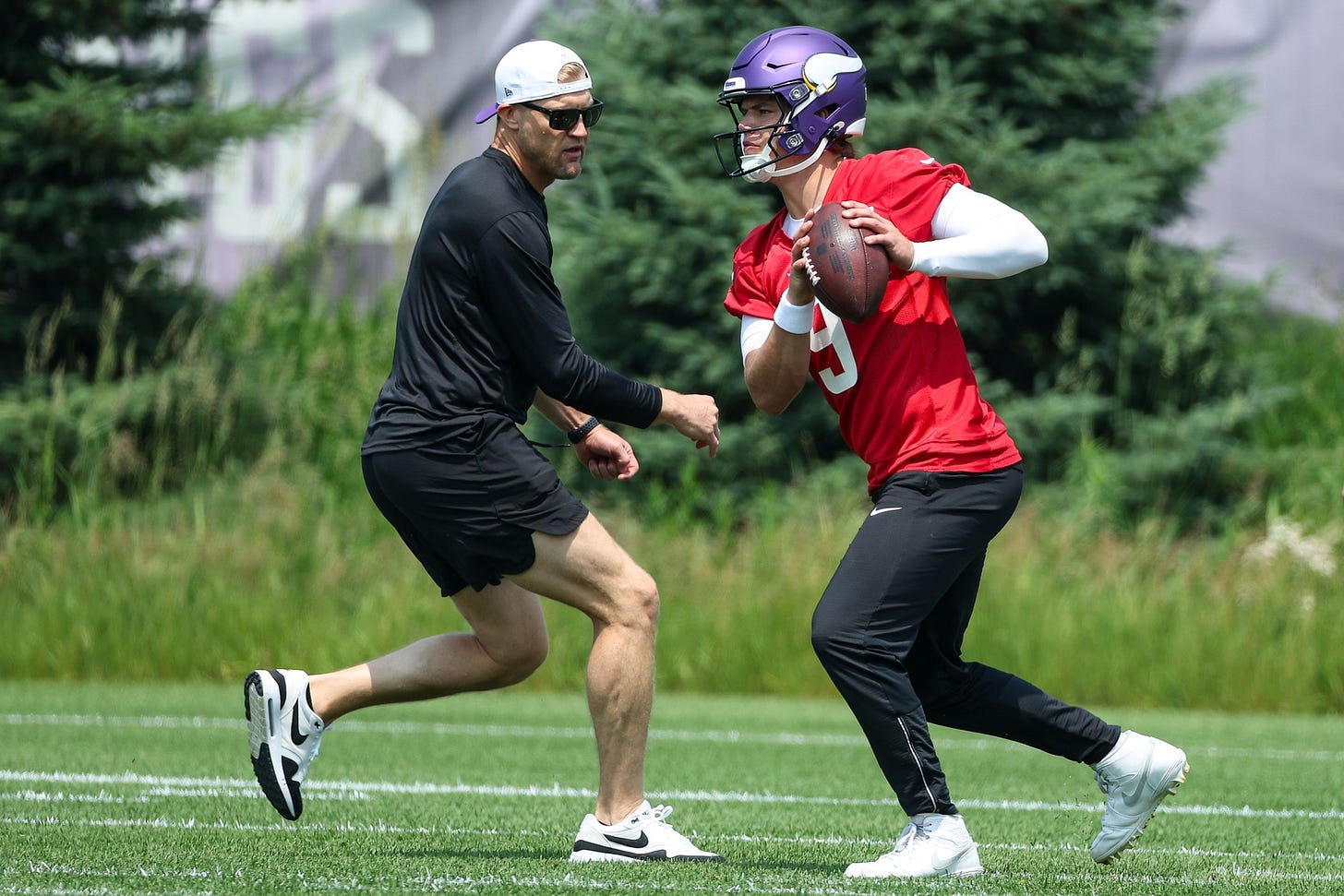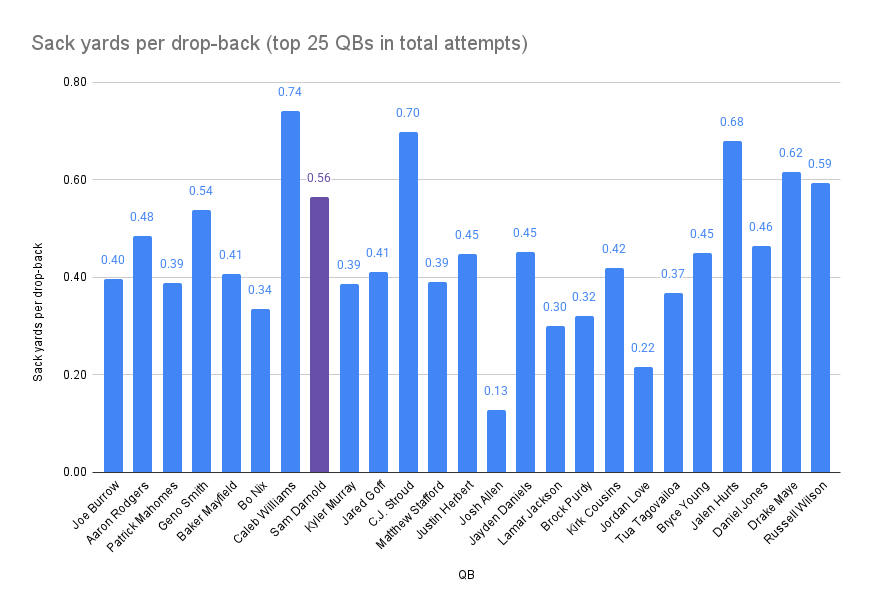One area JJ McCarthy can be better than Sam Darnold

By Matthew Coller
If you toss out the statement “sacks are a quarterback stat” among football analysts, you will get a lot of different responses. How can they be a QB stat when struggling offensive lines often allow quick pressures and sacks? Why do O-linemen take all the blame when the quarterback is the one who oftentimes sets protections and has the football in his hands?
As with most things, the truth is somewhere in the middle. For example, last year Jaguars QB Trevor Lawrence’s average time from snap to sack was 3.0 seconds, second quickest in the NFL (per PFF). CJ Stroud and Joe Burrow were both sacked 11 times in less than 2.5 seconds. It’s pretty darn hard to blame the quarterback for getting taken down in the backfield when the heat was in their face instantly.
At the same time, Will Levis took sacks on 30% of pressured drop-backs versus, which was 22% higher than the league’s best at sack avoidance Josh Allen (8%). Since Allen has been consistently prolific at pressure-to-sack ratio (12.2% career) and a veteran QB like Baker Mayfield has a 22% career rate (25.2% last year).
How did Sam Darnold perform in the metrics that tell us about QBs and sacks? He was taken down 48 total times and was 24th (of 44) in pressure-to-sack ratio. He had an average sack time of 3.6 seconds (30th of 44 longest time to sack) and the lowest percentage of throws under 2.5 seconds (30%).
Those numbers pretty clearly tell us that Darnold held onto the ball for a long time and oftentimes took sacks even when the offensive line initially held up the D-line.
The result off his sack-taking was 335 total yards lost. If we look at the top 25 QBs in total pass attempts and how many sack yards they lost per attempt, Darnold comes in with the fifth most in the NFL.
The trade off, of course, was that Darnold led the NFL in yardage gained on passes that traveled more than 20 yards downfield. He was more than 200 yards ahead of the next best deep passer (Justin Herbert).
Was the sacrifice worth it?
You could certainly argue that it was considering Darnold’s career best season and the Vikings won 14 games with a top-10 offense. Still, they averaged 6.8 net yards per attempt (YPA minus sacks), which was eighth in the NFL and ended 10th in Expected Points Added in the passing game.
But to demonstrate how much the sack losses kept the Vikings’ passing game from being among the best of the best, we can look at the 2024 Los Angeles Rams passing game. By individual metrics, Matthew Stafford wasn’t all that close to Sam Darnold. The Rams finished with a 93.7 team passer rating versus the Vikings’ 102.9. The Vikings had a higher yards per pass attempt, more touchdowns (35 to 22), around 200 more yards and about the same number of INTs (12 vs. 9). Yet the Rams had a nearly identical Expected Points Added and net yards per attempt because they lost 108 fewer yards to sacks.
What makes Josh Allen and Lamar Jackson so unique is that their playmaking ability out of structure doesn’t come with the sack losses that are typical of that type of play. Caleb Williams (68 sacks) and Jayden Daniels (47 sacks) both learned that lesson as rookies last year. Speedster Justin Fields has one of the highest sack percentages in NFL history.
Oftentimes last season Darnold was able to scramble out of trouble and hit big plays down field — like on his memorable touchdown pass against the Falcons or game-winner versus the Seahawks — but he would also end up running backward for drive-crushing sacks. The Vikings only finished 13th in the percentage of drives in which they produced points last year, which speaks to the boom or bust nature of the offense. You will hear quarterbacks say that taking a sack on a third down isn’t that bad because it’s no different than an incomplete pass but 32 of Darnold’s sacks (and 221 yards) were lost on first and second down last year. That’s a lot of drive-killers.
This is where JJ McCarthy enters the picture.
The biggest question the Vikings face this season is whether McCarthy can carry over the strong quarterback play that led them to 14 wins. This offseason the Vikings could have franchise tagged Darnold to keep him in place and attempted a patchwork job on the offensive line but instead they elected to make the switch to the inexperienced McCarthy.
Asking a first-year starter to throw 35 TDs and rank as the best deep passer in the game might be tricky but McCarthy can reduce the number of sack yards lost significantly. In college, he was called a “game manager” as a criticism to his game but he was only sacked 32 times on 795 career college drop-backs and had a pressure-to-sack rate of 14.3%.
While college is much different than the NFL, the analytics community has discovered correlation between taking sacks in college and the NFL. The two best QBs in the 2024 draft class at sack avoidance were Michael Penix Jr. and Bo Nix and both of them were elite in that category in their rookie seasons. Penix Jr. lost just 14 yards to sacks on 109 drop-backs and Nix was only taken down 24 times. In 2022 McCarthy was elite at 10.8% and then his sack rate increased to 16.8% in 2023 but that was still well below the likes of Caleb Williams (23.1%), Jayden Daniels (20.2%) and Drake Maye (19.3%).
If we think that hanging onto the football and taking sacks have to be a part of Kevin O’Connell’s style of play, Kirk Cousins’s eight games in 2023 might suggest otherwise. Cousins was 14th in time from snap to throw in ‘23 and threw 41% of his passes in under 2.5 seconds.
There was a gap between the percentage of downfield throws by 2023 Cousins and 2024 Darnold but it was only 8.0% versus 12.5% and Cousins had a slightly higher percentage of intermediate (11-20 yards) throws.
If McCarthy can still be a playmaker while being a little more Cousins-like in terms of getting rid of the football, the bar won’t have to be set at 35 touchdowns, 4,000 yards and a 102.9 QB rating. He can still be effective without needing to always hit on the booms because of the busts.
Of course, Darnold’s risky/exciting style should not take all the blame for his sack losses last year. In fact, PFF only blamed him for about 10% of his pressures, which was 14th in the league. Not only did the Vikings completely revamp an offensive line that featured the 28th graded pass blocking center by PFF (out of 30) and 46th (of 59) graded left guard, but they will presumably go from Cam Robinson in the second half of the season (35th of 60) to one of the best left tackles in the NFL in Christian Darrisaw.
Sacks may be a quarterback stat in many ways but the pass protecting abilities of the offensive line have a massive impact on the QB’s comfort. If the Vikings could superimpose the 2025 O-line onto 2024, who knows how far they might have gone. But that’s not how football works, so it’s up to McCarthy to take advantage of the improvements and avoid more sacks.


He throws well on the run and he’s got the agility to be elite at sack avoidance if he can master the pre snap side of things and sense the pressure well. I think we all expect him to get the pre snap part of the game down pretty well based on his intelligence and the dedication he has shown so far, so to me it’ll just come down to his ability to sense pressure in the pocket. I don’t see him holding onto the ball nearly as long as Darnold, but we’ll see. I do think KOC tells his QBs they have to be willing to take some negatives to get the big plays on offense. For Darnold, that was holding onto the ball to wait for the big shot down field. For Kirk, I think it was being more willing to throw picks into tight windows to take advantage of his accuracy.
There are two distinct but related points. Actually taking sacks is driven by QBs themselves. However, having a good offence requires good offensive line play. A sack is obviously worse than getting rid of the ball, and more likely to be a drive-killer. But, if the OL is getting thrashed routinely, the offence won't work.